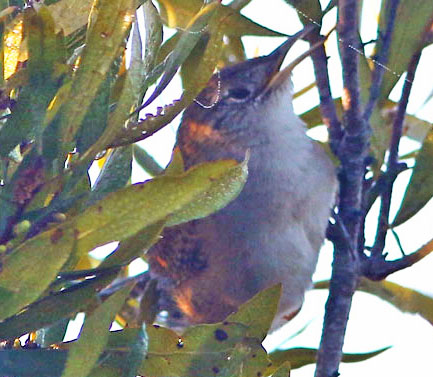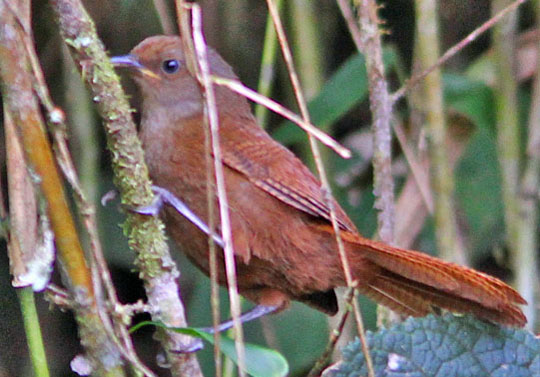| |
WRENS Troglodytidae |
- 85 species: 84 in New World, one in Old World
- DR personal total: 57 species (67%), 18 photo'd
|
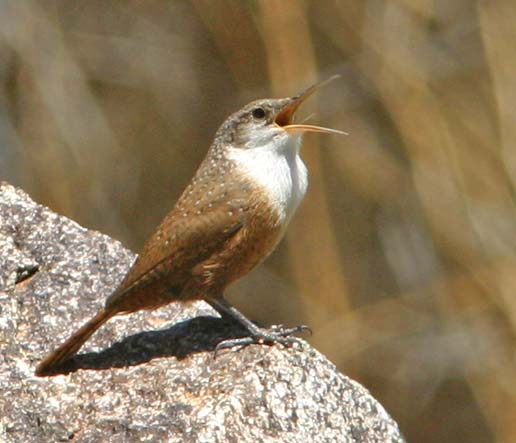 The wrens are (almost entirely) a New World group of small, active songbirds. Individual wrens can often be hard to see, but they are "always, it seems, dominating the soundscape" (Kroodsma & Brewer 2004). The beautiful cascading song of Canyon Wren (left), for example, brings life to the arid canyon country of the southwestern United States. It is found primarily in steep-walled canyons, and its characteristic and spirit-stirring song echoes between those canyon walls. It is the sound of the Grand Canyon and a good many other spectacular gorges. The wrens are (almost entirely) a New World group of small, active songbirds. Individual wrens can often be hard to see, but they are "always, it seems, dominating the soundscape" (Kroodsma & Brewer 2004). The beautiful cascading song of Canyon Wren (left), for example, brings life to the arid canyon country of the southwestern United States. It is found primarily in steep-walled canyons, and its characteristic and spirit-stirring song echoes between those canyon walls. It is the sound of the Grand Canyon and a good many other spectacular gorges.
The other western North American wren that is closely associated with rocky canyons, gorges, and rocky outcrops in arid country is Rock Wren (below). It breeds widely across the interior of southwestern U.S., in Mexico, and patchily to Costa Rica; it also resides on offshore islands, including Guadalupe I. west of Baja California, and the Farallon Is. west of San Francisco, California. Many populations are year-round residents but those in colder areas withdraw southwards in winter. This can spin off amazing vagrants as far away as the eastern U.S. This young Rock Wren (below) was a very rare vagrant in a Monterey Peninsula cemetery, where it frequented this one big rock, but otherwise preferred the stone-carved head-stones. |
 |
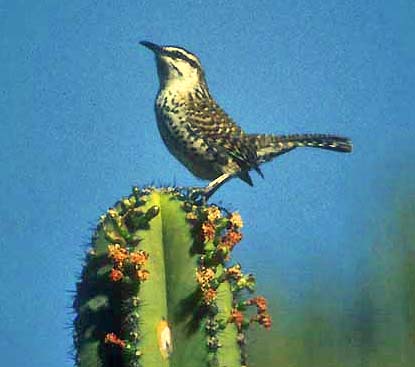 Two close relatives of Canyon Wren — Sumichrast's Wren Hyorchilus sumichrasti and Nava's Wren H. navai — are very local Mexican endemics. It was the Canyon-Wren-like song that helped us find Sumichrast's among the boulders in coffee-planted hills of Vera Cruz, and it was thrilling when the songster itself finally emerged. Sometimes it is the song of the wren that lingers in the memory. Two close relatives of Canyon Wren — Sumichrast's Wren Hyorchilus sumichrasti and Nava's Wren H. navai — are very local Mexican endemics. It was the Canyon-Wren-like song that helped us find Sumichrast's among the boulders in coffee-planted hills of Vera Cruz, and it was thrilling when the songster itself finally emerged. Sometimes it is the song of the wren that lingers in the memory.
A good many of the wrens are adapted to desert county, including a good percentage of the striking black-and-white barred wrens in genus Campylorhynchus. An excellent example is Bouchard's Wren (right), almost entirely restricted to the states of Oaxaca and Guerrero. Its habitat is arid thorn-scrub forest with giant cacti. Its Spanish language name implies it eats scorpions, but not enough is known about its lifestyle to say whether this is true. Genus Campylorhynchus currently has 13 species, so it is the largest genus in this family.
Among them is the well-known Cactus Wren of the American Southwest and Mexico (below). Its low harsh song is a background standard in movie "Westerns." Cactus Wren eats a wide variety of small prey, including wasps, grasshoppers, and small lizards, plus "some individuals learn to pry squashed insects from car radiator grills" (Kroodsma & Brewer 2005). It apparently gets adequate liquid from its diet and does not have a need to drink, although this one (below) was coming to a bird bath in Arizona. Cactus Wrens are both colorfully patterned and noisy. In the breeding season, they'll engage in "recognition displays" that includes opening their banded tails like a fan. There are currently 7 subspecies with the Cactus Wren complex; one subspecies in fragmented cactus scrub in coastal southern California (and nearly Baja California) is in serious decline (sandiegensis; Rea & Weaver 1990). |
 |
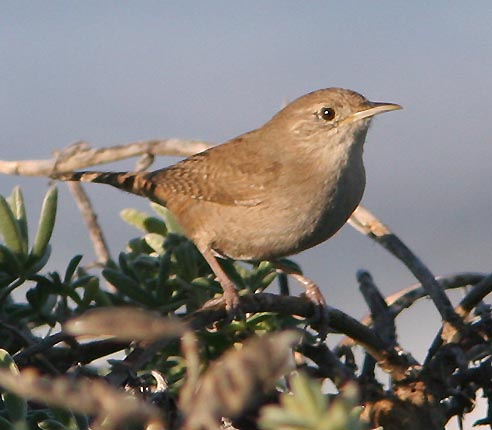 Widespread across North America, House Wren (left) is a familiar garden bird. Its bubbly song can dominate a spring walk in riparian habitat in the West, and it builds nests in a wide assortment of spots [unused mailboxes, planter-boxes, or a discarded hat!) in the East. Widespread across North America, House Wren (left) is a familiar garden bird. Its bubbly song can dominate a spring walk in riparian habitat in the West, and it builds nests in a wide assortment of spots [unused mailboxes, planter-boxes, or a discarded hat!) in the East.
The taxonomy of House Wrens is muddled. If maintained as a single species, it has the House Wrens has the "broadest latitudinal range of any native passerine in the New World, breeding from across most of Canada down to the southernmost part of South America, and into the West Indies" (Johnson 2020). Yet it may be a complex of multiple species.
Some years ago the AOU lumped "Brown-throated Wren," whose Mexican range reaches southeast Arizona, with House Wren, then considered to be a ubiquitous species throughout the New World, with up 32 subspecies. Kroodsma & Brewer (2005) started segmenting some of these into species, calling T. aedon "Northern House Wren" but splitting many Neotropical populations as Southern House Wren T. musculus. They even re-split Brown-throated Wren T. brunneicollis, plus split out wrens on Clarion I., Cozumel I., and the Falklands [T. tanneri, beani, and cobbi, respectively]. They did not, however, split very distinctive Caribbean populations, like the ones on Grenada [T. a. grenadensis]; those wrens were very noticeably different to my eye during a one-day stop on Grenada.
Currently (2020), Clarion and Cobb's Wrens remain split, but work is needed in the Caribbean, as conceded by Dickinson (2004). In short, there is still a lot to learn about the taxonomy of House Wren. Setting aside taxonomy, a recent review of the species (Johnson 2020) stated that "one can readily argue that we know more about the biology of the House Wren than any other wild species of bird in the world. New studies have focused on genetics, immunology, energetics and physiology, ecology, demography, reproductive and other behavior, sex allocation, communication, systematics, and more. . . [M]ore than 700 research papers, government reports, theses and dissertations had been published that touched on one or more aspects of House Wren biology." |
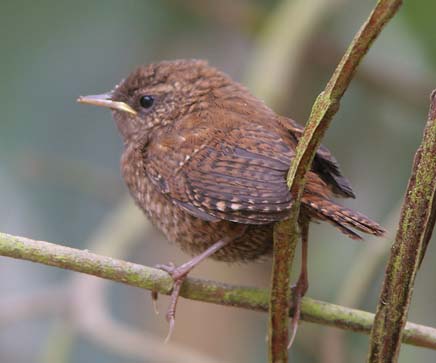 The other very widespread Troglodytes wren has been called simply "the Wren" in Eurasia — where it is the only wren in the Old World — and North American populations used to be called Winter Wren. Recent biochemical analysis (Toews & Irwin 2008) found that there may be up to six different clades of this wren (summarized in Kroodsma & Brewer 2005). They also determined that western and eastern populations in North America acted like biological species where they meet in the Canadian Rockies (Toews & Irwin 2008). The other very widespread Troglodytes wren has been called simply "the Wren" in Eurasia — where it is the only wren in the Old World — and North American populations used to be called Winter Wren. Recent biochemical analysis (Toews & Irwin 2008) found that there may be up to six different clades of this wren (summarized in Kroodsma & Brewer 2005). They also determined that western and eastern populations in North America acted like biological species where they meet in the Canadian Rockies (Toews & Irwin 2008).
In July 2010, the AOS checklist split the American populations in two species, and considered them both different species from Old World populations. The "ear-birding" blog has a very good analysis of differences in calls and song between the North American taxa. Those nesting here in western North America are named Pacific Wren; this photo (right) is of a just-fledged youngster with gular flanges. It is overall very dark rusty-brown, characteristic of this western group. Populations in eastern North America are now Winter Wren T. hiemalis. The latter is now a rare vagrant to the west, including California. |
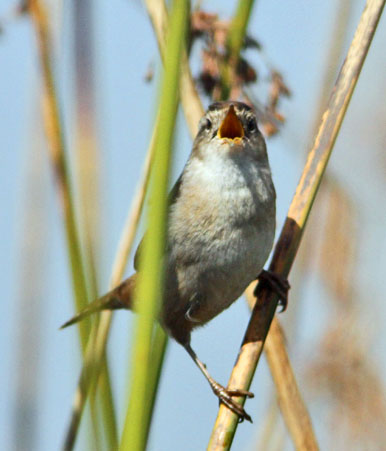 Research has shown that the song vocalizations of wrens are learned, at least in common North American species (see Kroodsma & Brewer 2005). One of those impressive singers inhabit marshes: the widespread Marsh Wren (left) that breeds across North America. Males defend territories and build a plethora of dummy 'nests' to attract females. Research has shown that the song vocalizations of wrens are learned, at least in common North American species (see Kroodsma & Brewer 2005). One of those impressive singers inhabit marshes: the widespread Marsh Wren (left) that breeds across North America. Males defend territories and build a plethora of dummy 'nests' to attract females.
The songs are quite different between western and eastern populations. It is not improbable that they, too, will be split into two or more species. I've posted a two-page gallery of photos and information on the three major "groups" of Marsh Wren.
The only known exception to the rule that songs are learned in wrens involves the North American populations of Sedge Wren Cistothorus platensis. Laboratory experiments that complemented field research showed that each nestling Sedge Wren improvises his own unique song, and no two are exactly alike (see Kroodsma & Brewer 2005). Like Marsh Wren, the taxonomy of Sedge Wren is uncertain. Currently (2020), there are 18 subspecies divided into 3 "groups," with populations in both North America and South America. Each group may deserve recognition as separate species.
Relationships within the Troglodytidae were studied in molecular research by Barker (2004), and the relationship of the wrens to other families explored in Barker et al. (2004). Their closest relatives appear to be gnatcatchers. A very odd Amazonian species, Tooth-billed Wren Odontorchilus cinereus, acts much like a gnatcatcher [the "tooth" is just a notch, and not noticeable in the field].
|
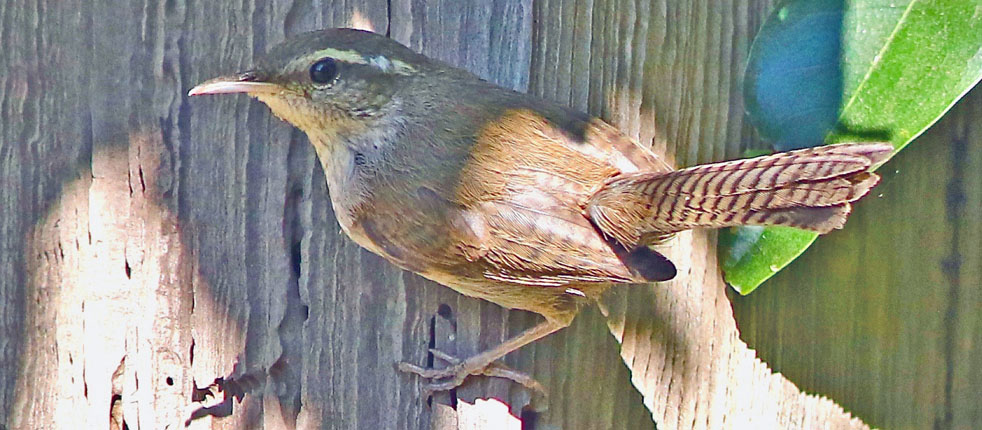 |
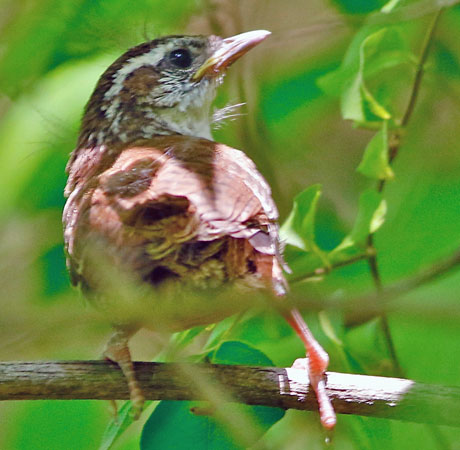 7 of the 19 genera of wrens are monotypic (meaning that there is just one species in each such genus). Canyon Wren and Rock Wren, shown at the top of this page, are two examples (genera Catherpes and Salpinctes, respectively). Another two monotypic genera apply to two widespread species in North America, one (mostly) in the west and one in the east. Where I live in California, the most ubiquitous wren is Bewick's Wren (above). It is the only member of genus Thryomanes, and is a resident species here in coastal California(unlike the migratory House Wren here). Bewick's Wren occupies a wide variety of habitats: riparian undergrowth, chaparral, coastal and montane scrub, and brushy gardens. It has a wide assortment of songs and calls, and it takes quite some time to learn most of them. Still, after 50+ years, there will be an occasional song that puzzles me. 7 of the 19 genera of wrens are monotypic (meaning that there is just one species in each such genus). Canyon Wren and Rock Wren, shown at the top of this page, are two examples (genera Catherpes and Salpinctes, respectively). Another two monotypic genera apply to two widespread species in North America, one (mostly) in the west and one in the east. Where I live in California, the most ubiquitous wren is Bewick's Wren (above). It is the only member of genus Thryomanes, and is a resident species here in coastal California(unlike the migratory House Wren here). Bewick's Wren occupies a wide variety of habitats: riparian undergrowth, chaparral, coastal and montane scrub, and brushy gardens. It has a wide assortment of songs and calls, and it takes quite some time to learn most of them. Still, after 50+ years, there will be an occasional song that puzzles me.
John J. Audubon collected the first Bewick's Wren on its wintering ground in Louisiana in 1821, and named for his friend, Thomas Bewick, a British engraver (the eastern population was more migratory than those in the west). Today, the species has nearly disappeared east of the Mississippi River. Declines may be linked to competition from the nest-destroying House Wren whose range has been expanding (Kroodsma & Brewer 2005).
Carolina Wren (right) is the only member of genus Thryothorus. In my rather brief experience in the eastern U.S., Carolina Wren is most common in the southeast (from Kentucky to Virginia and southwards) where every patch of woods in each Civil War battlefield that I visited seemed to hold a noisy pair, but these are shy and more likely heard than seen. My photo (right) is a recently-hatched youngster, still with its gape flange.
Zapata Wren (below left) is in yet-another monotypic genus (Ferminia). It is an endangered species restricted entirely to Zapata Swamp in Cuba. To me it recalled an overgrown Marsh Wren with a different vocabulary. It is quite shy and emerged only at the edge of the reeds, and only for brief moments
|
|
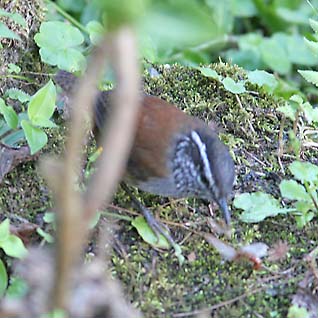
Many wrens are found in the Neotropics. At least 27 were initially assigned to genus Thryothorus, but molecular studies have split that genus into at least three different genera (Pheugopedius and Cantorchilus), leaving just five remaining in genus Thryothorus. In my experience, these are all real skulkers in undergrowth thickets, many in humid lowland rainforest, and they are found mostly by their songs. I don't actually have a photo of any of these real skulkers.
I do have a photo of a young Sharpe's Wren (above right) which is a shy undergrowth species in the cloud-forests of the Andes from Colombia to northern Peru. It is now one of four species in genus Cinnycerthia. Populations farther south from Peru to Bolivia were recently split as Peruvian Wren C. peruana and Fulvous Wren C. fulva. [The other Cinnycerthia wren is Rufous Wren C. unirufa.] All these are rusty-colored secretive wrens of wet, mossy montane forest, often with Chusquea bamboo. Notice that my photo (upper right) is of a fledgling with a gular flange. I'm beginning to think it is easier to photograph fledgling wrens than the wily adults.
Another Neotropic set found primarily by song are the five species of Henicorhina wood-wrens. White-breasted Wood-Wren Henicorhina leucosticta is a very common lowland species from Mexico to Peru and Brazil. Its highland equivalent is often Gray-breasted Wood-Wren (right), which ranges from Mexico to Bolivia (photographed here in Costa Rica). The other three wood-wrens have more restricted ranges in South American mountains. |
While many Neotropical wrens are montane birds, especially in the South American Andes, there are some astonishing wrens that live in the shadows on the floor of tropical lowland rainforest. These are also very difficult to observe but they have fabulous vocal abilities. This quality appears in the names given to some of them, such as Nightingale Wren Microcerculus philomela, Flutist Wren M. usutulas, and Song Wren Cyphorhinus phaeocephalus.
My favorite of these is Musician Wren (below, nice photo © Arthur Grosset). It is widespread in the Amazon Basin and has a number of subspecies (this one below is interpositus). Both sexes sing antiphonally, giving a fast, clear, haunting set of whistles, varying greatly in pitch, and switching between different motifs. Anthropologically it sounds like a little miniature boy whistling as he walks through the forest. This is quite true — the whistling is marvelous — leading one to believe in the existence of elves because of this amazingly-talented wren! |
|
Photos: The Canyon Wren Catherpes mexicanus was photographed on 13 Apr 2006 in Anza-Borrego State Park, California. The vagrant Rock Wren Salpinctes obsoletus was in the Pacific Grove cemetery, Monterey Co., California, on 2 Sep 2020. The Bouchard's Wren Camphyorhynchus jocosus at the Tehuacan pueblos, Oaxaca, Mexico, on 20 Dec 1995. The Cactus Wren Campylorhynchus brunneicapillus was in Hereford, Arizona, on 4 May 2015. The House Wren Troglodytes aedon parkmanii was at Pacific Grove, California, USA, on 1 Feb 2009. The fledgling Pacific Wren Troglodytes pacificus was at Moss Landing, California, on 29 June 2009. The singing Marsh Wren Cistothorus palustris was on territory at Zmudowski SP, Monterey Co., California, on 12 Mar 2011. The Bewick's Wren Thryomanes bewickii was at Andrew Molera SP, Monterey Co., California, on 8 July 2017. The fledgling Carolina Wren Thryothorus ludovicianus was at Davou Park, Lexington, Kentucky, on 26 May 2019. The singing Zapata Wren Ferminia cerverai was in Zapata Swamp, Cuba, on 7 Feb 2017. The fledgling Sharpe's Wren Cinnycerthia olivascens was at Owlet Lodge, Amazonas, Peru, on 22 Nov 2014. The Gray-breasted Wood-Wren Henicorhina leucophrys was at Mirador Cinchona, Costa Rica, on 19 Dec 2007. Arthur Grosset photographed the Musician Wren Cyphorhinus aradus at Rio Cristalino, Brazil, in Dec 2006.
All photos © Don Roberson, except those attributed © Arthur Grosset, and used with permission; all rights reserved.
Arthur has many great photos on his website.
Bibliographic note: There apparently is a family book, by Dave Brewer & Sean McMinn, with illustrations by Barry Kent MacKay, in the Yale Univ. Press series — A Guide to the Wrens, Dippers, and Thrashers of the World (2001) — but I have not seen it. The reviews were luke-warm. A quite entertaining introduction to this family, with some spectacular photos, is in Kroodsma & Brewer (2005).
Literature cited:
Barker, F.K. 2004. Monophyly and relationships of wrens (Aves: Troglodytidae): a congruence analysis of heterogeneous mitochondrial and nuclear DNA sequence data. Molec. Phylog. Evol. 31: 486–504.
Barker, F.K., A. Cibois, P. Schikler, J. Feinstein, and J. Cracraft. 2004. Phylogeny and diversification of the largest avian radiation. Proc. Natl. Acad. Sci. 101: 11040–11045.
Dickinson, E., ed. 2003. The Howard & Moore Complete Checklist of the Birds of the World. 3d ed. Princeton Univ. Press, Princeton, N.J.
Johnson, L.S. 2020. House Wren (Troglodytes aedon), version 1.0, in Birds of the World (A. F. Poole, ed.). Cornell Lab Ornith., Ithaca, NY, USA. https://doi.org/10.2173/bow.houwre.01
Kroodsma, D.E., and D. Brewer. 2005. Family Troglodytidae (Wrens), pp. 356–447 in Handbook of the Birds of the World (del Hoyo, J., A. Elliott & D.A. Christie, eds). Vol. 10. Lynx Edicions, Barcelona, Spain.
Rea, A.M. and K.J. Weaver. 1990. The taxonomy, distribution, and status of coastal California Cactus Wrens. Western Birds. 21: 81–126.
Toews, D.P.L., and D.E. Irwin. 2008. Cryptic speciation in a Holarctic passerine revealed by genetic and bioacoustic analyses. Molecular Ecology 17: 2691–2705.
|
|
|




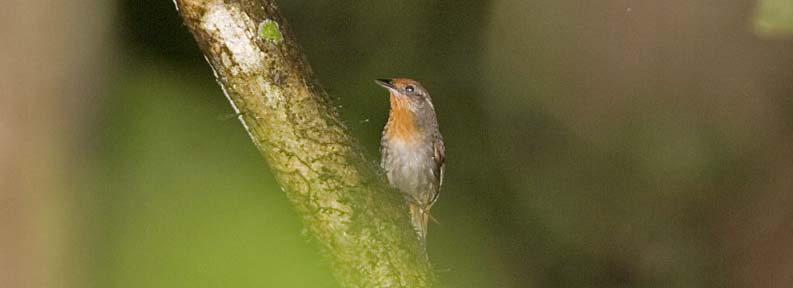
 The wrens are (almost entirely) a New World group of small, active songbirds. Individual wrens can often be hard to see, but they are "always, it seems, dominating the soundscape" (Kroodsma & Brewer 2004). The beautiful cascading song of Canyon Wren (left), for example, brings life to the arid canyon country of the southwestern United States. It is found primarily in steep-walled canyons, and its characteristic and spirit-stirring song echoes between those canyon walls. It is the sound of the Grand Canyon and a good many other spectacular gorges.
The wrens are (almost entirely) a New World group of small, active songbirds. Individual wrens can often be hard to see, but they are "always, it seems, dominating the soundscape" (Kroodsma & Brewer 2004). The beautiful cascading song of Canyon Wren (left), for example, brings life to the arid canyon country of the southwestern United States. It is found primarily in steep-walled canyons, and its characteristic and spirit-stirring song echoes between those canyon walls. It is the sound of the Grand Canyon and a good many other spectacular gorges.  Two close relatives of Canyon Wren — Sumichrast's Wren Hyorchilus sumichrasti and Nava's Wren H. navai — are very local Mexican endemics. It was the Canyon-Wren-like song that helped us find Sumichrast's among the boulders in coffee-planted hills of Vera Cruz, and it was thrilling when the songster itself finally emerged. Sometimes it is the song of the wren that lingers in the memory.
Two close relatives of Canyon Wren — Sumichrast's Wren Hyorchilus sumichrasti and Nava's Wren H. navai — are very local Mexican endemics. It was the Canyon-Wren-like song that helped us find Sumichrast's among the boulders in coffee-planted hills of Vera Cruz, and it was thrilling when the songster itself finally emerged. Sometimes it is the song of the wren that lingers in the memory.  Widespread across North America, House Wren (left) is a familiar garden bird. Its bubbly song can dominate a spring walk in riparian habitat in the West, and it builds nests in a wide assortment of spots [unused mailboxes, planter-boxes, or a discarded hat!) in the East.
Widespread across North America, House Wren (left) is a familiar garden bird. Its bubbly song can dominate a spring walk in riparian habitat in the West, and it builds nests in a wide assortment of spots [unused mailboxes, planter-boxes, or a discarded hat!) in the East.  The other very widespread Troglodytes wren has been called simply "the Wren" in Eurasia — where it is the only wren in the Old World — and North American populations used to be called Winter Wren. Recent biochemical analysis (Toews & Irwin 2008) found that there may be up to six different clades of this wren (summarized in Kroodsma & Brewer 2005). They also determined that western and eastern populations in North America acted like biological species where they meet in the Canadian Rockies (Toews & Irwin 2008).
The other very widespread Troglodytes wren has been called simply "the Wren" in Eurasia — where it is the only wren in the Old World — and North American populations used to be called Winter Wren. Recent biochemical analysis (Toews & Irwin 2008) found that there may be up to six different clades of this wren (summarized in Kroodsma & Brewer 2005). They also determined that western and eastern populations in North America acted like biological species where they meet in the Canadian Rockies (Toews & Irwin 2008). Research has shown that the song vocalizations of wrens are learned, at least in common North American species (see Kroodsma & Brewer 2005). One of those impressive singers inhabit marshes: the widespread Marsh Wren (left) that breeds across North America. Males defend territories and build a plethora of dummy 'nests' to attract females.
Research has shown that the song vocalizations of wrens are learned, at least in common North American species (see Kroodsma & Brewer 2005). One of those impressive singers inhabit marshes: the widespread Marsh Wren (left) that breeds across North America. Males defend territories and build a plethora of dummy 'nests' to attract females.  7 of the 19 genera of wrens are monotypic (meaning that there is just one species in each such genus). Canyon Wren and Rock Wren, shown at the top of this page, are two examples (genera Catherpes and Salpinctes, respectively). Another two monotypic genera apply to two widespread species in North America, one (mostly) in the west and one in the east. Where I live in California, the most ubiquitous wren is Bewick's Wren (above). It is the only member of genus Thryomanes, and is a resident species here in coastal California(unlike the migratory House Wren here). Bewick's Wren occupies a wide variety of habitats: riparian undergrowth, chaparral, coastal and montane scrub, and brushy gardens. It has a wide assortment of songs and calls, and it takes quite some time to learn most of them. Still, after 50+ years, there will be an occasional song that puzzles me.
7 of the 19 genera of wrens are monotypic (meaning that there is just one species in each such genus). Canyon Wren and Rock Wren, shown at the top of this page, are two examples (genera Catherpes and Salpinctes, respectively). Another two monotypic genera apply to two widespread species in North America, one (mostly) in the west and one in the east. Where I live in California, the most ubiquitous wren is Bewick's Wren (above). It is the only member of genus Thryomanes, and is a resident species here in coastal California(unlike the migratory House Wren here). Bewick's Wren occupies a wide variety of habitats: riparian undergrowth, chaparral, coastal and montane scrub, and brushy gardens. It has a wide assortment of songs and calls, and it takes quite some time to learn most of them. Still, after 50+ years, there will be an occasional song that puzzles me.